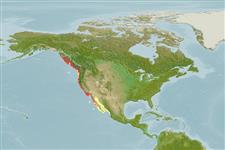分类 / Names
俗名 | 同种异名 | Catalog of Fishes (gen., sp.) | ITIS | CoL | WoRMS | Cloffa
Actinopterygii
辐鳍鱼纲 (条鳍鱼) >
Perciformes (Perch-likes) >
Embiotocidae (Surfperches)
Etymology: Cymatogaster: Greek, kyma,-atos = wave, swelling, bump + Greek, gaster = stomach (Ref. 45335); aggregata: Cymatogater foetus belly - alluding to the fact that it is a live bearer; aggregata crowded together (Ref. 4930).
环境 / 气候 / 范围
生态学
; 海洋; 半咸淡水 居于水底的; 非迁移的; 深度上下限 1 - 146 m (Ref. 2850). , preferred ?; 57°N - 21°N, 137°W - 105°W
Eastern Pacific: Wrangell, southeastern Alaska to Bahia San Quintin, northern Baja California, Mexico.
大小 / 重量 / 年龄
Maturity: Lm ? range ? - ? cm
Max length : 20.3 cm TL 雄鱼/尚未辨别雌雄; (Ref. 27547); common length : 11.5 cm TL 雄鱼/尚未辨别雌雄; (Ref. 12193); 最大年龄: 9 年 (Ref. 56049)
背棘 (总数): 8 - 11; 背的软条 (总数): 19-22; 臀棘 3; 臀鳍软条: 22 - 25; 脊椎骨: 33 - 37. Distinguished by the rather deep, compressed body, the large scales, and the three spines in the anal fin (Ref. 27547). Lateral line slightly arched, complete (Ref. 27547). Generally silvery, with back dusky to greenish; middle of sides toward head are scales with groups of fine black dots on them, forming about eight longitudinal stripes; the stripes are often interrupted, especially in females, by three pale yellow, vertical bands; paired fins colorless; dorsal and caudal fins plain or dusky; anal fin usually colorless, sometimes with a yellow blotch toward the front (Ref. 27547). Breeding males may be almost solid black and develop fleshy lobes on both sides of anal fin (Ref. 27547).
Usually in shallow water, around eelgrass beds, piers and pilings and commonly found in bays and quiet back waters (Ref. 2850). Also in calm areas of exposed coast (Ref. 2850). Enter estuaries and brackish waters (Ref. 114138) [noted from freshwaters in Ref. 2850, but it is unlikely or rarely]. Found in loose schools or aggregations (Ref. 2850, Ref. 114138). Young feed mainly on copepods, while adults eat various small crustaceans, mollusks, and algae (Ref. 27547). Viviparous, female carries the developing young (Ref. 205). Exhibit seasonal onshore-offshore movements (Ref. 27547).
Life cycle and mating behavior
成熟度 | 繁殖 | 产卵场 | 卵 | 孕卵数 | 仔鱼
Viviparous. Mating is preceded by courtship. The male moves slowly toward the female, who retreats. Her flight stimulates pursuit by up to 10 males. During the pursuit, males attempt to bring their anal regions in contact with that of the female. One male heads off the female, urging her away from the group of males and also driving them away. The female is conducted to the shelter of a rock or other object, where the courtship dance begins. In this dance, the male, with dorsal fin fully erect, swims by means of his pectoral fin in a figure eight pattern over the female, udulating in both the horizontal and vertical planes. The male then stops, faces the female head to head, quivers, then moves his jaws and undulates his dorsal fin. He then moves beside the female, facing in the same direction, and repeats the movements. Finally, the male tilts on his side, the female tilts slightly away from hin, and the anal regions are brought in contact with each other. Copulation lasts less than a second. Gestation takes five to six months. Bears 3 to 36 young. Female carries the developing young (Ref. 205). Males are mature and ripe at birth. Juvenile females are mated soon after being born (Ref. 27547).
Eschmeyer, W.N., E.S. Herald and H. Hammann, 1983. A field guide to Pacific coast fishes of North America. Boston (MA, USA): Houghton Mifflin Company. xii+336 p. (Ref. 2850)
CITES (Ref. 94142)
Not Evaluated
人类利用
渔业: 低经济; 游钓鱼种: 是的; 诱饵: occasionally
更多信息
参考文献养殖养殖信息品种遗传学基因序列遗传率疾病加工Mass conversion
工具
特别资料
下载 XML
网络资源
